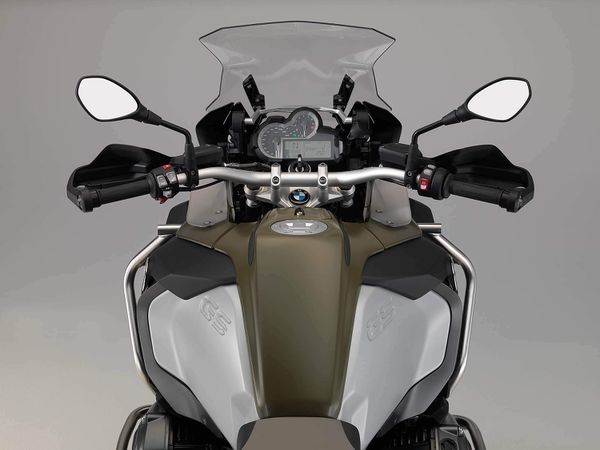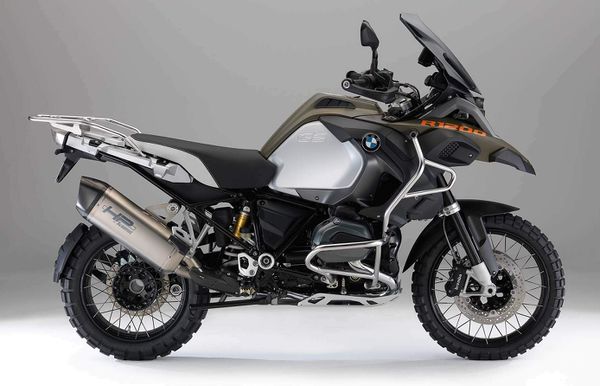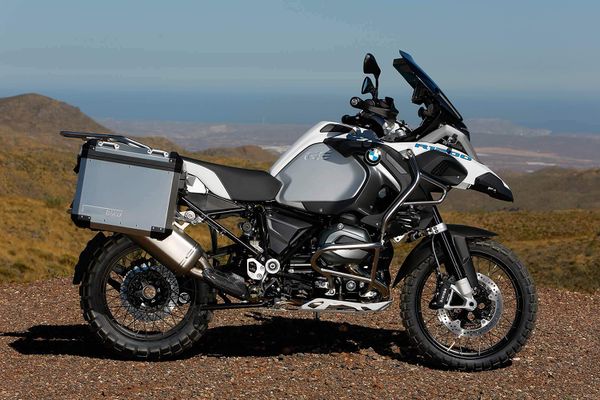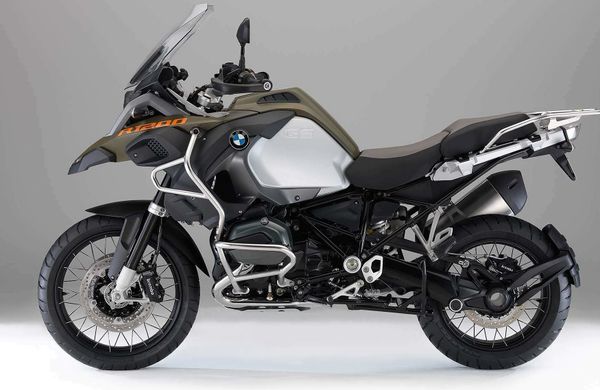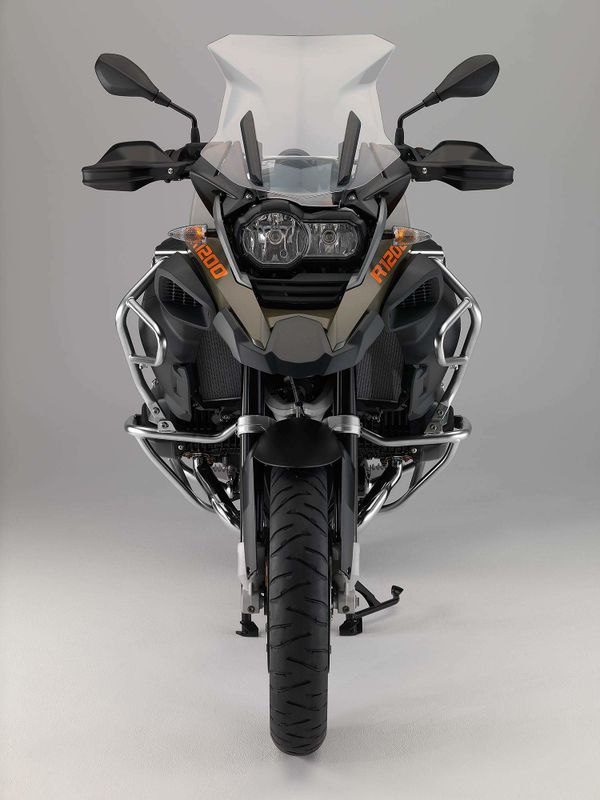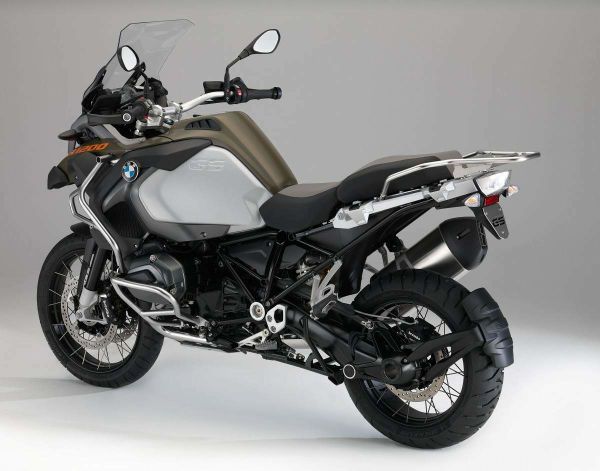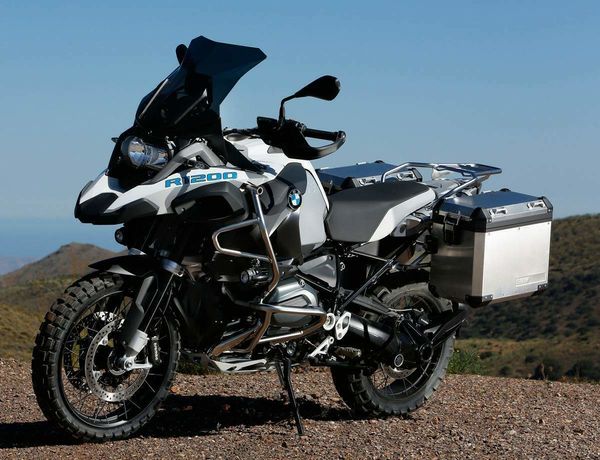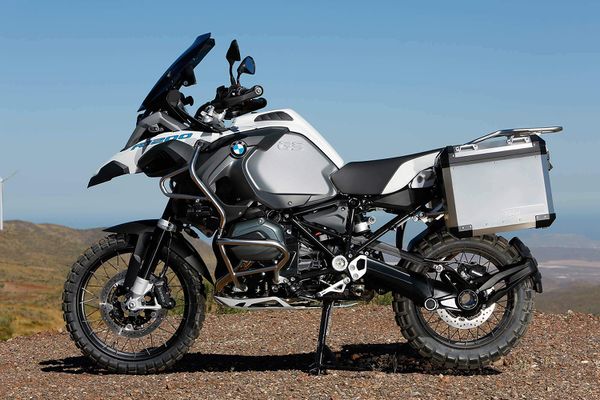BMW R1200GS LC Adventure
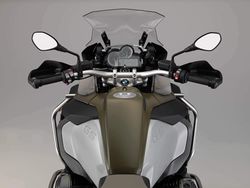 |
|
| BMW R1200GS LC Adventure | |
| Manufacturer | |
|---|---|
| Production | 2014 |
| Engine | Four stroke, two cylinder horizontally opposed Boxer, DOHC, 4 valves per cylinder, intake 40mm, outlet 34 mm |
| Compression ratio | 12.5:1 |
| Ignition | BMS-K |
| Battery | 12 V / 11.8 maintenance-free |
| Transmission | 6 Speed |
| Frame | Tubular steel bridge frame, engine self-supporting |
| Suspension | Front: BMW Motorrad Telelever; diameter 37 mm, central spring strut Rear: Cast aluminum single-sided swing arm with BMW Motorrad Paralever; WAD strut (travel-related damping), spring preload hydraulically adjustable (continuously variable) at handwheel, rebound damping adjustable at handwheel |
| Brakes | Front: 2x 305mm Hydraulically actuated twin disc brake, BMW Motorrad Integral ABS (standard, part intergal, disengageable) Rear: Single 275mm disc 2 piston caliper, BMW Motorrad Integral ABS (standard, part intergal, disengageable) |
| Front Tire | 120/70 R19 |
| Rear Tire | 170/60 R17 |
| Wheelbase | 1507 mm / 59.3 in. |
| Seat Height | 890 mm - 910 mm / 35.0 in - 35.8 in |
| Weight | 220 kg / 485 lbs (dry), 260 kg / 573 lbs (wet) |
| Fuel Capacity | 30 Liters / 7.9 US gal |
| Manuals | Service Manual |
Engine[edit | edit source]
The engine was a Liquid / Air cooled cooled Four stroke, two cylinder horizontally opposed Boxer, DOHC, 4 valves per cylinder, intake 40mm, outlet 34 mm. The engine featured a 12.5:1 compression ratio.
Drive[edit | edit source]
Power was moderated via the Anti-hopping wet clutch.
Chassis[edit | edit source]
It came with a 120/70 R19 front tire and a 170/60 R17 rear tire. Stopping was achieved via 2x 305mm Hydraulically actuated twin disc brake, BMW Motorrad Integral ABS (standard, part intergal, disengageable) in the front and a Single 275mm disc 2 piston caliper, BMW Motorrad Integral ABS (standard, part intergal, disengageable) in the rear. The front suspension was a BMW Motorrad Telelever; diameter 37 mm, central spring strut while the rear was equipped with a Cast aluminum single-sided swing arm with BMW Motorrad Paralever; WAD strut (travel-related damping), spring preload hydraulically adjustable (continuously variable) at handwheel, rebound damping adjustable at handwheel. The R1200GS LC Adventure was fitted with a 30 Liters / 7.9 US gal fuel tank. The bike weighed just 220 kg / 485 lbs. The wheelbase was 1507 mm / 59.3 in. long.
Photos[edit | edit source]
Overview[edit | edit source]
BMW R 1200GS LC Adventure
The arrival of the new BMW R 1200 GS Adventure marks the start of the next chapter in the success story of the large, boxer-engined GS models that extends back over more than 30 years. Since its debut in 2005, BMW Motorrad, the world's most successful manufacturer of large-capacity travel enduros, has firmly established the big GS Adventure as the definitive machine for long-distance travel. It transports two-wheeled explorers to the farthest-flung corners of the world and allows them to keep pressing on when others have long since turned back. The BMW R 1200 GS Adventure as the quintessential travel companion for expeditions and long-distance exploration. The new R 1200 GS Adventure continues in this same tradition, building on the dynamic performance characteristics and excellent off-road and touring capabilities of the R 1200 GS to provide the new, ultimate solution for globetrotters, travel enduro aficionados and touring riders with a passion for off-road action.
The new R 1200 GS Adventure is powered by the same spirited
air/liquid-cooled boxer engine featured on the R 1200 GS, with a displacement of
1,170 cc and an output of 92 kW (125 hp) at 7,750 rpm. The stand-out feature of
the power unit - introduced last year after being newly developed for the R 1200
GS - is the new precision cooling system which uses water instead of oil as a
cooling agent. Also new is the engine's through-flow, which is now vertical for
even more efficient power output, as well as the six-speed gearbox that is
integrated into the engine housing along with the wet clutch. For the first time
on a BMW production motorcycle, the maintenance-free cardan-shaft drive is now
positioned on the left-hand side. With the aim of further improving the
rideability of the R 1200 GS Adventure, especially on off-road terrain, the
drive's flywheel mass has been increased by around 950 grams and an extra
vibration damper has been incorporated into the powertrain.
Designed, engineered and equipped for supreme globetrotting capabilities. The big BMW GS Adventure is something of an icon amongst large-capacity travel enduros and is the top choice for world travellers on long-distance tours, even to the remotest regions of the planet. No matter whether it is negotiating tarmac roads, gravel tracks or rough terrain, the large-capacity GS Adventure gets its riders safely to their destination. This both compelled and inspired BMW Motorrad to make the new R 1200 GS Adventure even better in every way.
Like the R 1200 GS, the Adventure is also built around a robust and torsionally resistant tubular steel spaceframe. However, it has a larger 30-litre tank (10 liters more than on the R 1200 GS) to allow for an increased range, while the fuel tank itself is now made from lightweight aluminum.
The R 1200 GS Adventure already comes equipped as
standard with ABS,
Automatic Stability Control (ASC), as well as the two riding modes "Rain" and
"Road", which enable the riding characteristics to be adapted to most road
conditions. This further enhances the range of use of the new
R 1200 GS Adventure considerably, at the same time as providing a significant
safety boost on slippery surfaces in particular. Three further riding modes can be added by
ordering the optional Riding mode Pro feature, which is accompanied by the
Enduro ABS and Enduro ASC add-ons for off-road riding. The three extra riding
modes Dynamic, Enduro and Enduro Pro (which can be activated with a coding plug)
make it possible to adjust the settings of both ASC and ABS and, if fitted, the
semi-active suspension Dynamic ESA (Electronic Suspension Adjustment) to suit
the specific requirements of off-road operation.
Besides new bodywork styling with even more
masculine flair, the globetrotting abilities and greater off-road expertise of
the new R 1200 GS Adventure are clearly brought to the fore by a new chassis
set-up with a further 20 millimetres of spring travel, increased ground
clearance and a trailing arm with modified geometry for even better handling.
A larger windshield with convenient hand-wheel
adjustment, additional air flaps as well as hand protectors greatly increase
wind and weather protection. Wide enduro footrests, adjustable, reinforced
foot-operated levers and completely restyled bodywork add the finishing touches
to the look of the new R 1200 GS Adventure.
Highlights of the new BMW R 1200 GS Adventure:
Based on the same versatile overall concept
as the R 1200 GS, with spirited twin-cylinder boxer engine and agile
chassis, but with enhanced off-road prowess and globetrotting abilities.
Increased flywheel mass in the engine and additional vibration damper for even smoother running and superior rideability.
Spring travel 20 millimetres longer at front and rear compared to R 1200 GS.
10 millimetres more ground clearance than predecessor.
Modified geometry of trailing arm for even sharper handling.
Completely restyled bodywork in distinctly robust and masculine GS Adventure design.
30-litre fuel tank with similar range to predecessor.
ABS, ASC and two riding modes as standard.
Three further riding modes available as an ex-works option.
Semi-active suspension Dynamic ESA (Electronic Suspension Adjustment) available as an ex-works option.
More comfortable, tilt-adjustable bench seat.
Large, adjustable windshield and air flaps.
Wide enduro footrests.
Adjustable, reinforced foot-operated levers.
Robust engine and tank protection bar.
Wide range of special accessories and optional extras available ex-works.
BMW VS KTM ReviewAdventure touring has hit the Electronic Power Era.
BMWs original go-anywhere GS is now boasting big horsepower and computers that
control almost everything. KTMs entry into the class, the 1190 Adventure R, has
a distinctly leaner look and feel with even more power, albeit a more complex
yet less integrated electronics package.
These bikes represent the dreamy edge of hopping on a bike
and riding around the world, paved or not. They are the same yet distinctly
different, like a story told in two separate languages. So we took them on a
serious all-terrain trip to sort out which is the real king of adventure. To
safely and confidently off-road over a route that included snow, ice, mud, and
sand, both machines were shod with Kenda Big Block tires.
Despite power and performance being the main drivers of
sales pitches these days, comfort should be the first area considered in
reviewing these bikes. Contrary to its long-established reputation for rock-hard
foam, the KTM wins on seat comfort. But from there, the BMW has a roomier
layout, a better riding position both seated and standing, and more wind
protection, even with its smaller accessory windscreen fitted. In the battle
between ground clearance and a low seat height, the footpeg-to-seat distance on
the Austrian bike is a little cramped for most, and the handlebar bend
encourages sitting.
DOWNS
How the manufacturers mask the weight of these bruisers, as well as how they approach getting good handling, is attacked in different ways: The flat-twin allows a low center of gravity and a weight-forward bias that helps balance packed panniers, which we had on this trip. The GS is 53 pounds heavier (dry, with saddlebags) and feels it when stopped or in rough going but magically feels light when moving on most terrain. The KTMs lighter weight is obvious when in the saddle, but the mass is carried higher, so it feels more present. The KTMs dirt-friendly 21-inch front wheel gives lighter-feeling steering, but the front end isnt as planted in sweeping pavement corners. It is not unstable but not as arrow-like as the GS, either. The BMW has a tighter turning circle, but the 19-inch front wheel lets you feel more of the bumps on any surface. The suspension on both bikes is amazing, especially considering the heft of these machines. With the BMWs Dynamic ESA push-button parameter changes, the e-settings make sense, but the Hard damping mode lets you feel too much ground through the chassis. The KTM just has great suspension controlno nonsense. Both will bottom off-road, a sign you are going too fast or being too aggressive. Amazingly, you really feel the last 2 gallons of fuel on both of these bikes after a fill-up. The BMWs tank holds 7.9 gallons; the KTMs, 6.1.
Power is abundant on both bikes, and it should be noted that for most riding, especially off-road, traction control is kept exceptionally busy. But give the tires grip and the KTM destroys the BMW, making it seem as if the GS were caught between gears every time. And maybe that is the story of the powerplants: The BMW has three gears for every situation. The KTM has the right gear (both have appreciably wide-ratio six-speed transmissions). The GS pulls from 2,000 rpm with authority, wanting a shift at 7,000 and taking its time getting there when compared to the KTM. That said, the new GS is a revvy rocket compared to the last air/oil-cooled GS. And, in that change, the BMW has lost its off-idle, flywheel-augmented torque (despite the Adventures 2.1-pound-heavier flywheel as compared to the one on the standard GS). Combine this with a slightly vague clutch feel, and the bike is easy to stall in slower-than-first-gear technical off-road riding. The KTM doesnt pull until 3,000 rpm but goes way higher, way faster. KTM has also really improved clutch feel and engagement on the 1190 versus previous models. No stalling here.
UPS/DOWNS KTM 1190 Adventure R Wow, that is really fast! Electronics save you, dont sedate the ride Feels light and agile because it is Real suspension that works properly Bad things can happen quickly if you are not experienced enough to wrangle it. Shouldnt it go 300 miles? Eats knobby-type adventure tires for lunch Electronics plays a large role in these bikes wi th TC and ABS (and e-suspension on the BMW). Predetermined global settings can also be individually tailored. Systems on both bikes make it easy to change or activate/deactivate features once you learn the rules. Running or not? Reset with key off? Close throttle or pull clutch? See your owners manualthey wrote the instructions and youll need them at first.
Which has the better setup? The KTMs system is just milliseconds better in both ABS and TC. Were not sure if it has to do with the lean-angle sensors (cornering ABS is awesome) or just a newer or faster computer, but it pulses the brakes and controls the butterflies slightly better, slightly smoother, and a bit quicker. Youll never need to disable the TC or ABS on either machine unless you are in a very weird traction situation. Loaded with brand-specific luggage, the KTM looks ready but fails once in the dirt: Dust can lock your bags permanently, and a log can remove one of them instantly. In contrast, BMWs is tough and durable and can be expected to last off-road. Its just better made. Picking an outright winner is tough because both bikes are so good and do the same things in different ways. But we can do some word association to make it easier: BMW equals comfort; KTM equals performance. That said, the more advanced rider can appreciate and use the added performance the KTM offers and not be caught out or tricked by it. The BMW, built for the masses, holds the course that has made the GS famous.
Source
BMW vs KTMAdventure bikes offer many things to their owners, but most of all they provide possibilities. While a large majority may never see the other side of the horizon or hardcore trails, they are capable of bringing true adventure to those willing to get out there and push the limits. Big-bore adventure motorcycles are the top of the ADV food chain and the BMW R1200 GS and KTM 1190 Adventure are the two baddest gorillas in the jungle. Yet there are even more extreme versions available from each marque the R1200 GS Adventure and 1190 Adventure R. both of which are specially outfitted for serious travel off the beaten path. As soon as the GSA and Adventure R were announced debates raged online, and in the MotoUSA office, about which would be the ultimate mount for finding the end of the trail.
BMW has offered an Adventure model of the GS for years, but fans had to wait a year for the water Boxer version. For 2014 BMW outfitted the R1200 GS Adventure with all of the updates on the new-for-2013 R1200 GS. The new water-cooled Boxer Twin, along with a host of electronic rider aids, ups the capability and usability of the GSA. On top of the new mill and tech updates, the GSA gets a massive 7.9-gallon fuel tank, more suspension travel and off-road friendly hardware such as handguards, crashbars and burly footpegs. Equipped with the premium package, olive green paint and aluminum panniers our test unit rings in at an MSRP of $23,463.
KTM took a huge leap forward in the big-bore ADV bike word when it introduced the 1190 Adventure. In our first ride review we said it was the best streetbike KTM has produced to date. But with the 1190 Adventure R the Austrian company is looking to dominate every area of the segment. Replacing the ever popular but sparsely appointed 990, the 1190 brings a massive power increase, sophisticated electronic rider aids and more comfort. Changes from the standard 1190 Adventure to the R model are crashbars, more suspension travel, increased ground clearance and a 21/18-inch wheel and tire set-up. The KTM 1190 Adventure R as equipped for our test with KTM Power Parts aluminum panniers and mounting hardware will cost you $18, 091.
As these are the most extreme examples of the biggest ADV machines, we decided it would only be proper to scout out some legitimate off-road adventure, rather than just hitting the road from hotel to hotel and diner to diner. So instead we loaded up the bags with tents, sleeping bags, food, water and, of course, camera gear, and headed for the hills above Santa Barbara, California to find out what living with these two bikes on a real road trip would be like. Afterward, we spent two days in the mountains of Southern Utah for some additional seat time. Most of our miles were on dirt roads of varying quality, but we also hit the street and even pounded out a few hundred on the highway.
We also recorded some objective data with hard numbers such as curb weight, horsepower, torque and 0-60 acceleration. Subjective evaluations such as engine feel, suspension action and comfort carry equal weight on our scoresheet. We retained our standard comparison scoring, with a win in any category earning ten points and second-place getting eight. At the end we tally up the scores to declare a winner. And while the scoring helps suss out a ranking, this test was close almost too close to call. Both bikes excel in different ways, and depending on what is or isnt important to you, readers may find removing a category will swing the results in either bikes favor. With that lets get into the meat of this comparison.
The BMW R1200GS is the yardstick by which all other large ADV motorcycles have been measured. Several brands that have come close to toppling the GS giant, but BMW has always won out in the end. While various rivals have individually trumped the Beemer on power, handling and styling, none have been able put it all together in a comprehensive package. And that is were the GS Adventures strength lies. Its the king of all-rounders and epitome of the large-displacement ADV segment. And judging by the sales figures, buyers would agree, as the GSA is second only to the standard GS in global sales for BMW (with Adventure sales even with or slightly exceeding the standard GS in the U.S. market).
One look at the GSA and its obvious this bike is built to travel to faraway lands, and take a beating doing it. Crash bars, a massive front windshield and spoked wheels beg for rough terrain. Its not a particularly good-looking motorcycle in the traditional sense, but more handsome like a bulldog tough and rugged. Our test rider crew ranked it just below the KTM in looks, but beauty contests are not what the GSA is about. Its about function.
And function is what the GSA does. Its Flat Twin engine is a one of the best powerplants ever put in an ADV bike. The low-end torque pulls nicely on the street out of corners and chugs along on technical dirt roads. Your right wrist feels connected right to the crankshaft and power is easy to meter out. Up top the power is less impressive when compared to the 1190 Adventure R. While the power has increased from its oil/air-cooled predecessor, the water Boxer gets left in the dust by the upstart orange machine. On the MotoUSA dyno the BMW produced 105.07 peak horsepower, significantly less than the KTM (14 to be exact). However, the GSA just edged out the KTM in torque production with 76.25 lb-ft (a 0.93 lb-ft difference).
Those 105 rear-wheel ponies are more than enough to spin up the rear tire with less than perfect traction, but BMWs five riding modes (Road, Dynamic, Rain, Enduro and Enduro Pro) keep things in control in just about any situation you can get yourself into. Ride mode adjusts traction control as well as ABS settings. On the street Road and Dynamic are all you need and work even with the factory optional TKC Continentals. In the dirt your two options of Enduro and Enduro Pro are a must. Enduro, which is calibrated for non-knobby tires, mellows out the power delivery and adjusts traction control to allow more wheelspin. Our default mode when we hit the dirt was Enduro Pro, which is tuned for knobby tires. The Enduro Pro throttle response is snappier, with the rear tire spinning up nicely. The rear ABS is also disabled in Pro, giving a dirt-savvy rider the utmost control available from the rider modes. The ABS works well in both settings and slows the GSA with control and authority. The traction control has a harder cutoff when it kicks in compared the KTM, and this put it just behind when riding full-tilt.
Brakes on the BMW are strong and the ABS is excellent. Every ABS setting fits the riding mode perfectly, and not once did we feel the need to disable it completely. We appreciate the Enduro Pro setting, which allows the rear tire to lock up and slide when needed. Lever feel is consistent no matter the surface and has a connected feel with both street or dirt. So the brakes are excellent, but so are those on the KTM, and we ranked them even in the scoring.
On the street the GSA is the king of the corners. Its smaller diameter 19-inch front wheel offers more road confidence. With a more road-friendly tire profile (even with knobbies) the front turns into the bends with a linear feel. Combined with a lower center of gravity and more comfortable riding position the BMWs handling had us playing rock-paper-scissor for who would get the GSA key on the street.
When the dirt started it was the same game, but for who would not be on the BMW. In the dirt the heavier GSA proved less nimble and could only hope to hold onto the KTMs dust. Suspension action was less plush and settled when the bumps appeared in any setting. On the BMW you just couldnt push as hard on the trails as the KTM. The GSA could still go anywhere we wanted in the dirt, but it was more work and took longer. The KTM is better suited for aggressive off-road riders.
Spending a total of five days in the saddle brings rider comfort to the forefront and the GS Adventure excels in this regard. A wide, flat seat offers plenty of support for pounding out the miles while the larger, more easily-adjusted windscreen better shields the rider from the elements. The GSAs large footpegs are a huge upgrade over the standard units and the seat-to-peg distance is relaxed, making transition from sitting to standing easy. In just comfort alone the BMW is unrivaled in this comparison, but adding on the creature comforts like heated grips and cruise control puts it over the top. If you have aspirations of 500-plus mile days, the BMW is the clear choice.
Another big ADV plus for the GSA is fuel capacity and range. Throughout out test we recorded an average of 37 mpg. That is a quite a bit less than BMW claims of 55 mpg at 56 mph, but we didnt always go that slow We were very aggressive with the throttle, both on- and off-road, but with a 7.9-gallon fuel tank, the BMW still sports a range of nearly 300 miles (435 miles by BMWs conservative speed estimate). The KTMs 200-mile range isnt even close.
After tabulating the scoresheet, the 2014 BMW R1200 GS Adventure came up two points short of the KTM in this comparison. While its an official second-place, this is far from total defeat for the BMW. The GSA is the most comfortable touring platform and king on the asphalt. Depending or your adventure-touring needs, the GSA might be the clear winner. This comparison is almost too close to call.
KTMs ready to race credo might not fit the ADV segment or the KTM 1190 Adventure R in the literal sense, but theres no doubt the 1190 is one of the more extreme examples of an adventure-touring motorcycle. While you wont be hitting the race course, you can feel and see the racing DNA in this hardcore ADV mount. The R model builds on the standard 1190 Adventure with more suspension travel, increased ground clearance and dirt focused wheel/tire combination. The R also sources crashbars and a smaller windscreen. Aggression is Adventure Rs game; a very different take on the segment compared to the BMW GSA.
Throw a leg over the 1190 Adventure R and the cockpit feels sparse in comparison to the GS Adventure. Creature comforts such as heated grips and cruise control are absent, and the windshield is miniscule compared to the BMW. Additionally the seat is thinner, resembling a large dirt bike unit. As the miles rolled on during our interstate blasts the decreased wind protection and less comfortable seat made it the less desirable of the two. Granted its nearly $5000 lower sticker price leaves plenty of leftover cash for farkles and comfort additions. But stock for stock, the GSA trounces the Adventure R in the ergonomics and comfort game.
While it may not be the bees knees while pounding out the miles, twist the throttle and all is forgiven. While the GSAs Boxer is stout, the 1190s V-Twin is a monster. On the dyno the KTM blasted out 119.07 rear-wheel horsepower, 14 more than the GS. Just a tick behind the GS in the torque department, the 1190 put forth 75.31 ft-lb of torque. Get on the gas and the Adventure R rockets away from the BMW, with more horsepower and less weight, especially on the roll on. In our 0-60 test the KTM reached the mark one tenth of a second ahead at 3.1 seconds.
And the 1190 Adventure R puts the power to the ground well, on- or off-road. KTMs traction control (MTC) is one of the most seamless weve ever tested and is the absolute best here. Four modes (Sport. Street, Rain and Off-road) meter the ride-by-wire throttle butterflies to temper the power dependent on wheel slip and lean angle. Sport mode lets the rear wheel spin up on the street before cutting the power back without any perceptible cut. Street mode keeps things in line while still allowing full power. Rain reduces the horsepower to a maximum of 100 at the crank and intervenes early. In the dirt the Off-road mode also reduces the power to 100 hp, but allows for plenty of wheelspin. Once the rear wheel speed doubles the front the MTC controls the power, but even so the effect is much less abrupt and noticeable in comparison to the BMW. You can just whack the throttle to the stop, let the rear end step out and drift like a champ.
While you dont have to shift much on the BMW, the KTM works better rowing through the gears to find the optimum ratio. This isnt a problem as the ratios are spot on and shifts are solid, just not as solid as the BMW. The KTMs clutch feel and engagement is much better, however, and this proved the difference in the transmission, clutch and gearing category.
The KTMs suspension and handling off-road allow you to capitalize on the 1190s excellent Off-road MTC settings. While the front and rear travel is nearly identical to the BMW, the more conventional upside-down forks have more feel and control over the GSAs telelever frontend. There is much less hucking and bucking from the 1190 when the going gets rough. For dirt usage, the KTM is the boss in this contest.
On the street, things arent as rosy. With a 21-inch front wheel, the front-end feel is less surefooted and confident, more like a dirt bike. As lean angles increase on curvey roads, the further the BMW pulls ahead. If you are a dirt junky and road work is just to get from trailhead to trailhead, the 1190 Adventure R is the best choice.
One area the KTM does miss the mark as an ADV bike is the fuel range. During our testing the 1190 averaged 33 mpg. We were usually hard on the gas when we were anywhere but on the superslab thanks to the KTMs awesome motor. We just wanted to feel the rush all the time; in return the fuel economy was well below the Beemer. With a smaller 6.1-gallon tank, the range is limited to just 201 miles. That falls well short of the rival BMW.
Braking power from the ABS-equipped Brembos is excellent with exceptional feel. One up the KTM has on the BMW in the braking department is the lean sensitive ABS, which does work well; the system is magic. If the R was equipped with a 19-inch front wheel it would destroy its German competition, but the 21-inch wheel with knobs doesnt stop as hard or with as much feel on the front as the BMW. A better ABS system but less power, has us calling a draw in this contest.
At the end of the test the KTM 1190 Adventure R squeaked out a win against the BMW R1200 GS Adventure. And that is a huge accomplishment. The BMW has been the gold standard for so long and even being on the same level is a win for any ADV machine. As we said before, this contest is almost too close to call, but the pure performance of the 1190 puts it over the top. If the adventure begins when the road ends, the KTM is our clear-cut winner.
Source
| Make Model | BMW R 1200GS LC Adventure |
|---|---|
| Year | 2014 |
| Engine Type | Four stroke, two cylinder horizontally opposed Boxer, DOHC, 4 valves per cylinder, intake 40mm, outlet 34 mm |
| Displacement | 1170 cc / 71.4 cub in. |
| Bore X Stroke | 101 x 73 mm |
| Cooling System | Liquid / Air cooled |
| Compression | 12.5:1 |
| Induction | Throttle valve 52 mm Carburetion BMS-X Emission control Closed-loop 3-way catalytic converter |
| Fuel | Premium unleaded (95 RON) |
| Ignition | BMS-K |
| Alternator | Three-phase alternator 620 W (nominal power) |
| Battery | 12 V / 11.8 maintenance-free |
| Starting | Electric |
| Electrical System | Headlight H7W / LED (SA) Starter 0.9 kW |
| Exhaust Management | Fully-controlled three-way catalytic converter |
| Max Power | 92 kW / 125 hp @ 7750 rpm |
| Max Torque | 125 Nm / 12.7 kgf-m / 92 lb-ft @ 6500 rpm |
| Clutch | Anti-hopping wet clutch |
| Transmission | 6 Speed |
| Final Drive | Shaft |
| Gear Ratios | 1st 2.438 / 2nd 1.714 / 3rd 1.296 / 4th 1.059 / 5th 0.943 / 6th 0.848:1 |
| Transmission Ratio | 2.91:1 |
| Frame | Tubular steel bridge frame, engine self-supporting |
| Front Suspension | BMW Motorrad Telelever; diameter 37 mm, central spring strut |
| Front Wheel Travel | 210 mm / 8.3 in. |
| Rear Suspension | Cast aluminum single-sided swing arm with BMW Motorrad Paralever; WAD strut (travel-related damping), spring preload hydraulically adjustable (continuously variable) at handwheel, rebound damping adjustable at handwheel |
| Rear Wheel Travel | 220 mm / 8.7 in |
| Front Brakes | 2x 305mm Hydraulically actuated twin disc brake, BMW Motorrad Integral ABS (standard, part intergal, disengageable) |
| Rear Brakes | Single 275mm disc 2 piston caliper, BMW Motorrad Integral ABS (standard, part intergal, disengageable) |
| Front Wheel | Cast aluminum wheels laced wire spokes |
| Rear Wheel | Cast aluminum wheels laced wire spokes |
| Front Rim | 3.00 x 19 in. |
| Rear Rim | 4.50 x 17 in. |
| Front Tire | 120/70 R19 |
| Rear Tire | 170/60 R17 |
| Wheel Castor | 99.6 mm / 3.9 in. |
| Steering Head Angle | 64.5 ° |
| Dimensions | Height 1450 mm / 57.1 in Width 953 mm / 37.5 in Length 2210 mm / 87.0 in |
| Wheelbase | 1507 mm / 59.3 in. |
| Seat Height | 890 mm - 910 mm / 35.0 in - 35.8 in |
| Dry Weight | 220 kg / 485 lbs |
| Wet Weight | 260 kg / 573 lbs |
| Fuel Capacity | 30 Liters / 7.9 US gal |
| Reserve | 4 Liters / 1.1 US gal |
